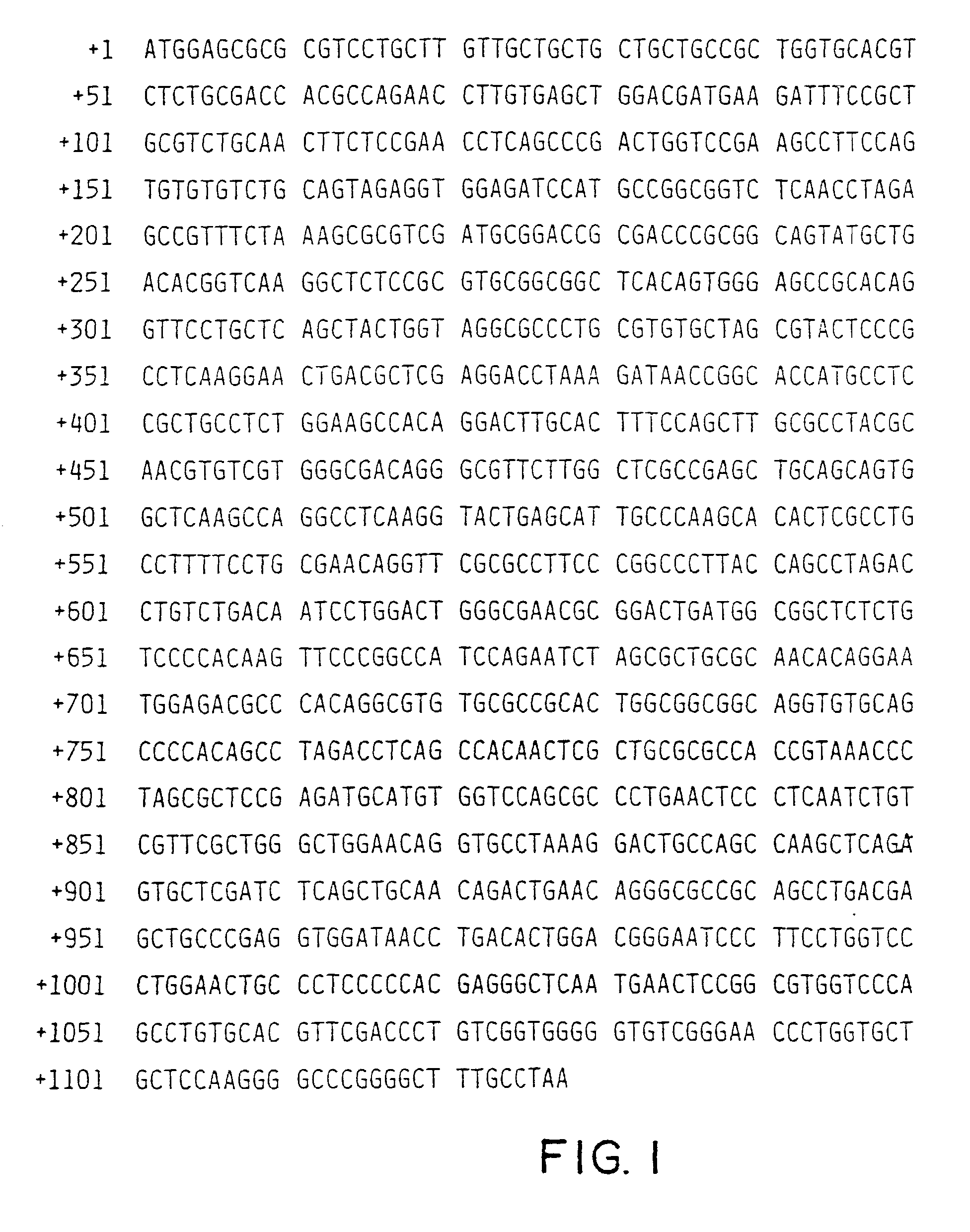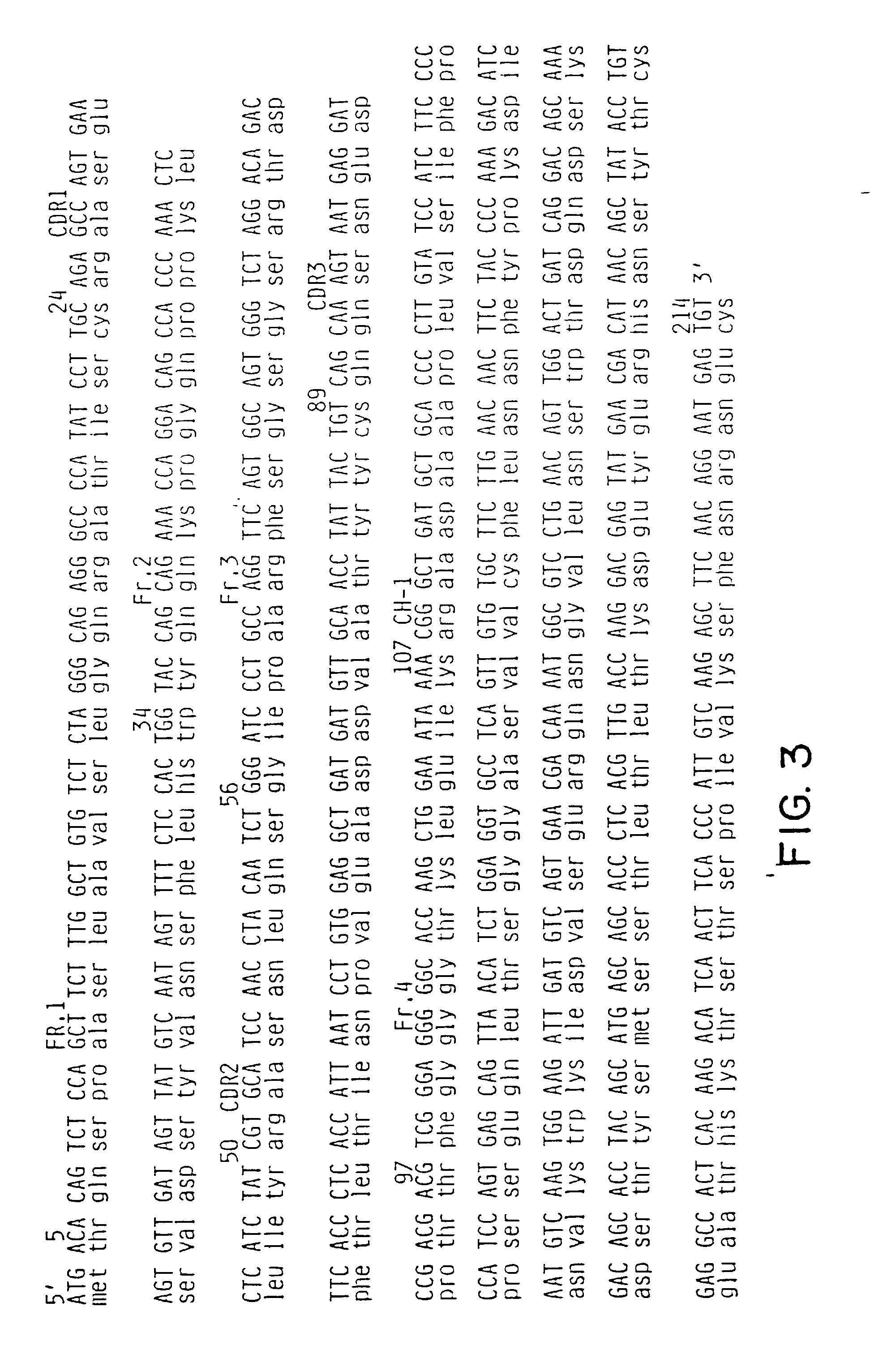Methods and compositions for inhibiting CD14 mediated cell activation
- Summary
- Abstract
- Description
- Claims
- Application Information
AI Technical Summary
Benefits of technology
Problems solved by technology
Method used
Image
Examples
example 1
Generation of Soluble CD14 (sCD14) and Production of Monoclonal Antibodies
[0094] A. Cloning of sCD14
[0095] A copy of the human CD14 gene was obtained. The description of the cloning of this gene, from a human monocytic cell line (HL-60) (American Type Culture Collection, ATCC No. 240), is described in Blood, 73:284 (1989), incorporated herein by reference. The CD14 gene was excised from this expression vector and cloned into the mammalian expression vector pEE14 (Celltech). This vector has an inducible glutamine synthetase gene (GS) which was used to amplify the inserted DNA fragments containing the CD14 gene. A full-length DNA sequence of the gene was cloned into pEE14. Cells expressing soluble CD14 were identified as an ELISA assay by reactivity with commercially available anti-CD14 mAbs. One clone, identified as 523, was demonstrated to express both soluble CD14 and a membrane associated form which could be detected by FACS analysis. The soluble form of clone 523 was determined...
example 2
Characterization of Monoclonal Antibodies
[0099] A. FACS Analysis of CD14+ Positive Cells with Anti-CD14 Monoclonal Antibodies
[0100] THP-1 cells (American Type Culture Collection, ATCC No. TIB 202) were induced with dihydroxyvitamin D3 for 48 hours and cells were then washed with DMEM (Dulbecco's modified Eagles medium with 4.5 g / L glucose, 90% fetal bovine serum, 10% followed by PBS with 1% BSA and 0.02% azide). One million cells / tube were reacted with first antibody (anti-CD14s supernatants) at 1:2 dilution for 45 minutes at 4° C. Cells are washed with PBS / BSA / azide. The second antibody was added (goat anti-mouse IgG, FITC-labeled (Cappel)) at a 1:250 dilution for 30 minutes at 4° C. Cells are washed 2× with same buffer. Pellets resuspended in 1 ml of buffer. Fluorescence intensity was measured by a Cytofluorograph (Ortho Instruments). The results are shown in FIGS. 6 through 10.
[0101] B. Determination of Binding Affinity of Anti-sCD14 Monoclonal Antibodies for Soluble CD14
[010...
example 3
[0137] Messenger RNA was extracted from monoclonal antibody producing cell lines using the method of Chomczynkski and Sacchi, Anal. Bio., 162:156-159 (1987), incorporated herein by reference. Reverse transcription was performed using murine specific 3″ antibody primers (IgG1 or k) and the resulting cDNAs subjected to PCR (Supplier) according to the manufacturer's instructions, using a panel of murine specific 5′ antibody primers described in Huse, et al., Science, 246:1275-1281 (1989), incorporated herein by reference. Heavy and light chain DNA fragments were gel purified and digested with appropriate enzymes. The 672 base pair heavy chain fragment was cloned into the Spe1 / Xho1 site of pBluescript II KS+ and sequenced using the automated ABI Model 373A DNA sequencer, according to the manufacturer's instructions. The 642 base pair light chain fragment was cloned into the Sst1 / Xba of pBluescript II KS+ and sequenced in a similar manner.
[0138] SEQ ID NO:1 a...
PUM
| Property | Measurement | Unit |
|---|---|---|
| Molar density | aaaaa | aaaaa |
| Molar density | aaaaa | aaaaa |
| Digital information | aaaaa | aaaaa |
Abstract
Description
Claims
Application Information
 Login to View More
Login to View More - R&D
- Intellectual Property
- Life Sciences
- Materials
- Tech Scout
- Unparalleled Data Quality
- Higher Quality Content
- 60% Fewer Hallucinations
Browse by: Latest US Patents, China's latest patents, Technical Efficacy Thesaurus, Application Domain, Technology Topic, Popular Technical Reports.
© 2025 PatSnap. All rights reserved.Legal|Privacy policy|Modern Slavery Act Transparency Statement|Sitemap|About US| Contact US: help@patsnap.com



